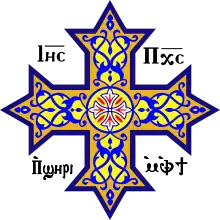Matthew the Apostle | |
|---|---|
 Saint Matthew (c. 1611) by Peter Paul Rubens | |
| Apostle, Evangelist, and Martyr | |
| Born | Capernaum,[1] Galilee, Roman Empire |
| Died | 1st century AD Ethiopia |
| Venerated in | |
| Canonized | Pre-Congregation |
| Feast |
|
| Attributes | Angel |
| Patronage | Accountants; Salerno, Italy; bankers; Osorno, Chile; tax collectors; perfumers; civil servants[2] |
| Major works | Gospel of Matthew |
Matthew the Apostle (Saint Matthew)[lower-alpha 1] is named in the New Testament as one of the twelve apostles of Jesus. According to Christian traditions, he was also one of the four Evangelists as author of the Gospel of Matthew, and thus is also known as Matthew the Evangelist.
The claim of his gospel authorship is rejected by most biblical scholars, though the "traditional authorship still has its defenders."[3] The New Testament records that as a disciple, he followed Jesus. Church Fathers such as Irenaeus and Clement of Alexandria claim that Matthew preached the gospel to the Jewish community in Judea, before going to other countries.
In the New Testament

Matthew is mentioned in Matthew 9:9[4] and Matthew 10:3[5] as a tax collector (in the NIV) who, while sitting at the "receipt of custom" in Capernaum, was called to follow Jesus.[6] He is also listed among the Twelve Disciples, but without identification of his background, in Mark 3:18, Luke 6:15 and Acts 1:13.[7] In passages parallel to Matthew 9:9, both Mark 2:14[8] and Luke 5:27[9] describe Jesus's calling of the tax collector Levi, the son of Alphaeus, but Mark and Luke never explicitly equate this Levi with the Matthew named as one of the twelve apostles.
Ministry
The New Testament records that as a disciple, Matthew followed Jesus. Afterwards, the disciples withdrew to an upper room (Acts 1:10–14)[10] (traditionally the Cenacle) in Jerusalem.[11] The disciples remained in and about Jerusalem and proclaimed that Jesus was the promised Messiah.
In the Babylonian Talmud (Sanhedrin 43a), "Mattai" is one of five disciples of "Jeshu".[12]
Early Church Fathers such as Irenaeus (Against Heresies 3.1.1) and Clement of Alexandria say that Matthew preached the gospel to the Jewish community in Judea, before going to other countries. Ancient writers are not in agreement as to which other countries these are, but almost all sources mention Ethiopia.[11] The Catholic Church and the Orthodox Church each hold the tradition that Matthew died as a martyr and the Babylonian Talmud appears to report his execution in Sanhedrin 43a.[13][14]
According to Church tradition, while preaching in Ethiopia, Matthew converted, and then consecrated to God, Ephigenia of Ethiopia, the virgin daughter of King Egippus.[15] When King Hirtacus succeeded Egippus, he asked the apostle if he could persuade Ephigenia to marry him. Matthew thus invited King Hirtacus to liturgy the following Sunday, where he rebuked him for lusting after the girl, as she was a nun and therefore was the bride of Christ. The enraged King thus ordered his bodyguard to kill Matthew who stood at the altar, making him a martyr.[16]
The Gospel of Matthew

Early Church tradition holds that the Gospel of Matthew was written by the apostle Matthew. This tradition is first attested, among the extant writings of the first and second centuries, with the early Christian bishop Papias of Hierapolis (c. AD 60–163),[17] who is cited by the Church historian Eusebius (AD 260–340), as follows: "Matthew collected the oracles [in Greek, logia: sayings of or about Jesus] in the Hebrew language [Hebraïdi dialektōi], and each one interpreted [hērmēneusen – perhaps 'translated'] them as best he could."[18][lower-alpha 2][19] Likewise, early Christian theologian Origen (c. 184–c. 253) indicates that the first gospel was written by Matthew,[20][21] and that his gospel was composed in Hebrew near Jerusalem for Hebrew Christians and translated into Greek. The Hebrew original was kept at the Library of Caesarea. Sometime in the late fourth or early fifth century the Nazarene Community transcribed a copy for Jerome,[22] which he used in his work.[23] This Gospel was called the Gospel according to the Hebrews[24] or sometimes the Gospel of the Apostles[25][26] and it was once believed that it was the original to the 'Greek Matthew' found in the Bible.[27] However, this has been challenged by modern biblical scholars such as Bart D. Ehrman and James R. Edwards.[28][29][lower-alpha 3][30][31]

Most modern scholars hold that the Gospel of Matthew was written anonymously, and not by Matthew.[32][3] The author is not named within the text, and scholars have proposed that the superscription "according to Matthew" was added sometime in the second century.[33][34]
Non-canonical or apocryphal gospels
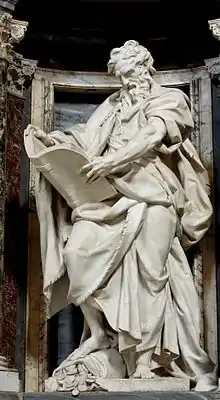
In the 3rd century, Jewish–Christian gospels attributed to Matthew were used by Jewish–Christian groups such as the Nazarenes and Ebionites. Fragments of these gospels survive in quotations by Jerome, Epiphanius and others. Most academic study follows the distinction of Gospel of the Nazarenes (36 fragments), Gospel of the Ebionites (7 fragments), and Gospel of the Hebrews (7 fragments) found in Schneemelcher's New Testament Apocrypha. Critical commentators generally regard these texts as having been composed in Greek and related to Greek Matthew.[35] A minority of commentators consider them to be fragments of a lost Aramaic- or Hebrew-language original.
The Gospel of Pseudo-Matthew is a 7th-century compilation of three other texts: the Gospel of James, the Flight into Egypt, and the Infancy Gospel of Thomas.
Jerome relates that Matthew was supposed by the Nazarenes to have composed their Gospel of the Hebrews,[23] though Irenaeus and Epiphanius of Salamis consider this simply a revised version of the canonical Gospel. This Gospel has been partially preserved in the writings of the Church Fathers, said to have been written by Matthew.[30] Epiphanius does not make his own the claim about a Gospel of the Hebrews written by Matthew, a claim that he merely attributes to the heretical Ebionites.[31]

Veneration
Matthew is recognized as a saint in the Roman Catholic, Eastern Orthodox, Lutheran[36] and Anglican churches (see St. Matthew's Church). His feast day is celebrated on 21 September in the West and 16 November in the East. (Those churches which follow the traditional Julian calendar would keep the day on 29 November of the modern Gregorian calendar, being 16 November in the Julian calendar.) He is also commemorated by the Orthodox, together with the other Apostles, on 30 June (13 July), the Synaxis of the Holy Apostles. His tomb is located in the crypt of Salerno Cathedral in southern Italy. Matthew is remembered in the Church of England with a Festival on 21 September.[37]
Like the other evangelists, Matthew is often depicted in Christian art with one of the four living creatures of Revelation 4:7.[38] The one that accompanies him is in the form of a winged man. The three paintings of Matthew by Caravaggio in the church of San Luigi dei Francesi in Rome, where he is depicted as called by Christ from his profession as a tax gatherer, are among the landmarks of Western art.
In Islam
The Quran speaks of Jesus' disciples but does not mention their names, instead referring to them as "helpers to the work of Allah".[39] Muslim exegesis and Quran commentary, however, name them and include Matthew amongst the disciples.[40] Muslim exegesis preserves the tradition that Matthew and Andrew were the two disciples who went to Ethiopia to preach the message of God.
In architecture
The Basilica of Annunciation in Nazareth houses a capital that depicts Matthew the Apostle and his story regarding King Eglypus of Aethiopia and his sons. It shows how Matthew is leading them away from the demon in the far corner of the capital. The biblical story tells of Matthew converting the king and his sons to Christianity. Not only does this capital depict an act carried out by Matthew in the Bible, it foreshadows Matthew being a martyr. When Matthew the Apostle was murdered, he then became a martyr for the Christian religion as being killed for his faith and teachings given the demon in the corner of the capitol. The iconography of this capital helps understand the religion of the time period since it was just coming into Christendom. This shows the cross between Ethiopia and Nazareth as these are where the capitals are today.[2][41][37][42][43][44]
In fiction
Gallery
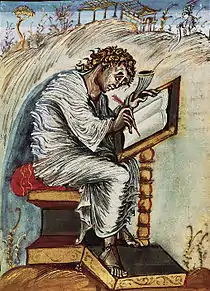 Saint Matthew in the Ebbo Gospels
Saint Matthew in the Ebbo Gospels Saint Matthew writing the Gospel with an angel holding the volume, an Islamic miniature c. 1530 by Kesu Das for the Mughal king
Saint Matthew writing the Gospel with an angel holding the volume, an Islamic miniature c. 1530 by Kesu Das for the Mughal king.jpg.webp) The Calling of Saint Matthew, 1599–1600, Caravaggio
The Calling of Saint Matthew, 1599–1600, Caravaggio Saint Matthew and the Angel by Guido Reni, 1620–1630
Saint Matthew and the Angel by Guido Reni, 1620–1630 Stained-glass depiction of Saint Matthew at St. Matthew's German Evangelical Lutheran Church in Charleston, South Carolina
Stained-glass depiction of Saint Matthew at St. Matthew's German Evangelical Lutheran Church in Charleston, South Carolina_-_Triumphal_arch_-_Sant'Apollinare_in_Classe_-_Ravenna_2016.jpg.webp) Icon of Saint Matthew in the Basilica of Saint Apollinaris, Ravenna
Icon of Saint Matthew in the Basilica of Saint Apollinaris, Ravenna A terracotta sculptural model, Giuseppe Bernardi
A terracotta sculptural model, Giuseppe Bernardi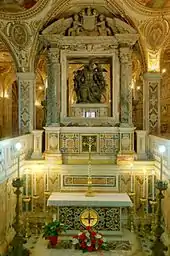 The Crypt at Salerno Cathedral
The Crypt at Salerno Cathedral Statue of Saint Matthew by August Wredow at the roof of the Helsinki Cathedral
Statue of Saint Matthew by August Wredow at the roof of the Helsinki Cathedral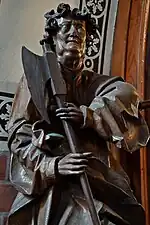 Matthew with the hatchet from Claus Berg (Güstrow Cathedral)
Matthew with the hatchet from Claus Berg (Güstrow Cathedral)
See also
References
Notes
- ↑ Biblical Hebrew: מַתִּתְיָהוּ, romanized: Mattityahu, shortened to מַתִּי, Matti (whence Arabic: مَتَّى, romanized: Mattā), meaning 'Gift of YHWH'; Imperial Aramaic: ܡܰܬ݁ܰܝ, romanized: Mattai; Koinē Greek: Μαθθαῖος, romanized: Maththaîos, or Ματθαῖος, Matthaîos; Coptic: ⲙⲁⲧⲑⲉⲟⲥ, romanized: Mattheos; Latin: Matthaeus
- ↑ Eusebius, "History of the Church" 3.39.14–17, c. 325 CE, Greek text 16: "ταῦτα μὲν οὖν ἱστόρηται τῷ Παπίᾳ περὶ τοῦ Μάρκου· περὶ δὲ τοῦ Ματθαῖου ταῦτ’ εἴρηται· Ματθαῖος μὲν οὖν Ἑβραΐδι διαλέκτῳ τὰ λόγια συνετάξατο, ἡρμήνευσεν δ’ αὐτὰ ὡς ἧν δυνατὸς ἕκαστος. Various English translations published, standard reference translation by Philip Schaff at CCEL: "[C]oncerning Matthew he [Papias] writes as follows: 'So then(963) Matthew wrote the oracles in the Hebrew language, and every one interpreted them as he was able.'(964)" Online version includes footnotes 963 and 964 by Schaff.
Irenaeus of Lyons (died c. 202 CE) makes a similar comment, possibly also drawing on Papias, in his Against Heresies, Book III, Chapter 1, "Matthew also issued a written Gospel among the Hebrews in their own dialect" - ↑ See also the two-source hypothesis.
Citations
- ↑ Easton 1897.
- 1 2 "Cathedral of St. Matthew the Apostle, Washington, D.C". Stmatthewscathedral.org. 21 September 2013. Retrieved 10 July 2014.
- 1 2 Allison 2010, p. 27.
- ↑ Matthew 9:9
- ↑ Matthew 10:3
- ↑ Matthew 9:9,Mark 2:15–17, Luke 5:29
- ↑ Mark 3:18, Luke 6:15 and Acts 1:13.
- ↑ Mark 2:14
- ↑ Luke 5:27
- ↑ Freedman 2001, p. 130–133, 201.
- 1 2 Jacquier 1911.
- ↑ Schneemelcher 2003, p. 17.
- ↑ Lardner 1838, p. 299.
- ↑ Bock 2002, p. 164.
- ↑ The Golden Legend of Jacobus de Voragine, translated and adapted by Ryan, Granger and Helmut Ripperger. (Arno Press: Longmans, Green & Co) 1941. pp. 561–566.
- ↑ The Autonomous Orthodox Metropolia of Western Europe and the Americas (ROCOR). St. Hilarion Calendar of Saints for the year of our Lord 2004. St. Hilarion Press (Austin, TX). p. 70.
- ↑ Martin 2012.
- ↑ Turner 2008, p. 15–16.
- ↑ Bingham 1998, p. 64.
- ↑ Edwards 2009, p. 18.
- ↑ Repschinski 2000, p. 14.
- ↑ Nicholson 1879, p. 82.
- 1 2 Saint Jerome 2000, p. 10.
- ↑ Hultgren & Haggmark 1996, p. 122.
- ↑ Nicholson 1879, p. 26.
- ↑ Dods 1858, p. iv.
- ↑ Harrison 1964, p. 152.
- ↑ Edwards 2009, p. 245.
- ↑ Ehrman 1999, p. 43.
- 1 2 Mills & Wilson 2003, p. 942.
- 1 2 Epiphanius of Salamis 1987, p. 129.
- ↑ Muddiman & Barton 2010, p. 27.
- ↑ Harrington 1991, p. 8.
- ↑ Nolland 2005, p. 16.
- ↑ Vielhauer & Strecker 2003, p. 542.
- ↑ ELCA 2006, p. 57.
- 1 2 "The Calendar". The Church of England. Retrieved 27 March 2021.
- ↑ Revelation 4:7
- ↑ Quran 3:49-53
- ↑ Noegel & Wheeler 2003, p. 86.
- ↑ "Saint Matthew". franciscanmedia.org. Franciscan Media. Retrieved 21 September 2020.
- ↑ Nees, Lawrence; Boehm, Barbara Drake; Holcolmb, Melanie (2018). "Pleasurable Perplexity: Reflecting the Holy City". The Jewish Quarterly Review. 108 (4): 551–561. ISSN 0021-6682. JSTOR 90025854.
- ↑ Jasmine A. L. Kilburn. 2003. "The Contrasted `Other' in the Old English Apocryphal Acts of Matthew, Simon and Jude." Neophilologus 87 (1) (01): 137–151.
- ↑ Naomi, Simhony. 2020. "The Central Synagogue of Nazareth Illit and its Architectural Dialogue with Nazareth’s Basilica of the Annunciation." Humanities & Social Sciences Communications 7 (1) (12).
Sources
- Bartlet, James Vernon (1911). . In Chisholm, Hugh (ed.). Encyclopædia Britannica. Vol. 17 (11th ed.). Cambridge University Press.
- Allison, Dale C. Jr. (22 April 2010). Muddiman, John; Barton, John (eds.). The Gospels. Oxford University Press. p. 27. ISBN 978-0-19-958025-5.
- Bingham, D. Jeffrey (1998). Irenaeus' Use of Matthew's Gospel in Adversus Haereses. Peeters Publishers. ISBN 978-90-6831-964-4.
- Bock, Darrell L. (2002). Studying the Historical Jesus: A Guide to Sources and Methods. Baker Academic. ISBN 978-1-58558-596-0.
- Davies, William David; Finkelstein, Louis (1984). The Cambridge History of Judaism: Volume 2, The Hellenistic Age. Cambridge University Press. ISBN 978-0-521-21929-7.
- Dods, John Bovee (1858). Gibson Smith (ed.). The Gospel of Jesus. G. Smith.
Gospel of the Apostles.
- Easton, Matthew George (1897). . Easton's Bible Dictionary (New and revised ed.). T. Nelson and Sons.
- Edwards, James R. (2009). The Hebrew Gospel and the Development of the Synoptic Tradition. Wm. B. Eerdmans Publishing. ISBN 978-0-8028-6234-1.
- Ehrman, Bart D. (23 September 1999). Jesus: Apocalyptic Prophet of the New Millennium. Oxford University Press. p. 45. ISBN 978-0-19-802888-8.
- Ehrman, Bart D. (2009). A Brief Introduction to the New Testament. Oxford University Press. p. 56. ISBN 978-0-19-536934-2.
- "Lesser Festivals, Commemorations, and Occasions". Evangelical Lutheran Worship. Evangelical Lutheran Church in America. 2006. ISBN 978-0-8066-5672-4 – via Augsburg Fortress.
- Epiphanius of Salamis (1987). The Panarion of Ephiphanius of Salamis. Vol. Book I (sects 1–46). Translated by Frank Williams. Brill. ISBN 90-04-07926-2.
- Freedman, David Noel (2001). The Anchor Bible Reference Library. Doubleday.
- Harrison, Everett Falconer (1964). Introduction to the New Testament. Wm. B. Eerdmans Publishing. ISBN 9780802847867.
- Hezser, Catherine (2001). Jewish Literacy in Roman Palestine. Mohr Siebeck. ISBN 978-3-16-147546-7.
- Hultgren, Arland J.; Haggmark, Steven A. (1996). The Earliest Christian Heretics: Readings from Their Opponents. Fortress Press. ISBN 978-0-8006-2963-2.
- Jacquier, Eugène (1911). . In Herbermann, Charles (ed.). Catholic Encyclopedia. Vol. 10. New York: Robert Appleton Company.
- Saint Jerome (2000). Thomas P. Halton (ed.). On Illustrious Men (The Fathers of the Church, Volume 100). CUA Press. ISBN 978-0813201009.
- Lardner, Nathaniel (1838). "St Matthew, Apostle and Evangelist". The Works of Nathaniel Lardner. Vol. 5. W. Ball.
- Martin, Dale B. (2012). "Introduction to New Testament History and Literature" (PDF). oyc.yale.edu. Yale University. Retrieved 21 September 2020.
- Marx, Werner G. (April–June 1979). "Money Matters in Matthew". Bibliotheca Sacra. 136 (542): 148–157.
- Mills, Watson E.; Wilson, Richard F. (2003). Mercer Commentary on the New Testament. Mercer University Press. ISBN 978-0-86554-864-0.
- Muddiman, John; Barton, John (2010). The Gospels. Oxford University Press. ISBN 978-0-19-958025-5.
- Nicholson, E.B. (1879). The Gospel according to the Hebrews, its fragments tr. and annotated, with a critical analysis of the evidence relating to it.
- Noegel, Scott B.; Wheeler, Brandon M. (2003). Historical Dictionary of Prophets in Islam and Judaism. Lanham, MD: Scarecrow Press (Rowman & Littlefield). ISBN 978-0810843059.
- Orr, James, ed. (1915). "Matthew". The International Standard Bible Encyclopedia. Chicago: The Howard-Severance Co.
- Repschinski, Boris (2000). The Controversy Stories in the Gospel of Matthew: Their Redaction, Form und [sic] Relevance for the Relationship Between the Matthean Community and Formative Judaism. Vandenhoeck & Ruprecht. ISBN 978-3-525-53873-9.
- Schneemelcher, Wilhelm, ed. (2003). New Testament Apocrypha: Writings relating to the Apostles; Apocalypses and related subjects. Translated by Robert McLachlan Wilson. Westminster John Knox Press. ISBN 978-0-664-22722-7.
- Theissen, Gerd (2003). The New Testament: History, Literature, Religion. T & T Clark. ISBN 978-0-567-08949-6.
- Vielhauer, Philipp; Strecker, Georg (2003). Schneemelcher, Wilhelm (ed.). New Testament Apocrypha: Writings relating to the Apostles; Apocalypses and related subjects. Translated by Robert McLachlan Wilson. Westminster John Knox Press. ISBN 978-0-664-22722-7.
- NEES, LAWRENCE; Barbara Drake Boehm; Melanie Holcolmb (2018). "Pleasurable Perplexity: Reflecting the Holy City". The Jewish Quarterly Review. 108 (4): 551–561. doi:10.1353/jqr.2018.0038. JSTOR 90025854. S2CID 165897158.
Further reading
- Aune, David E., ed. (2001). The Gospel of Matthew in current study. Eerdmans. ISBN 978-0-8028-4673-0.
- Aune, David E. (1987). The New Testament in its literary environment. Westminster John Knox Press. ISBN 978-0-664-25018-8.
- Beaton, Richard C. (2005). "How Matthew Writes". In Bockmuehl, Markus; Hagner, Donald A. (eds.). The Written Gospel. Oxford University Press. ISBN 978-0-521-83285-4.
- Browning, W. R. F. (2004). Oxford Dictionary of the Bible. Oxford University Press. ISBN 978-0-19-860890-5.
- Burkett, Delbert (2002). An introduction to the New Testament and the origins of Christianity. Cambridge University Press. ISBN 978-0-521-00720-7.
- Casey, Maurice (2010). Jesus of Nazareth: An Independent Historian's Account of His Life and Teaching. Continuum. ISBN 978-0-567-64517-3.
- Clarke, Howard W. (2003). The Gospel of Matthew and Its Readers. Indiana University Press. ISBN 978-0-253-34235-5.
- Cross, Frank L.; Livingstone, Elizabeth A., eds. (2005) [1997]. "Matthew, Gospel acc. to St.". The Oxford Dictionary of the Christian Church (3 ed.). Oxford University Press. p. 1064. ISBN 978-0-19-280290-3. Archived from the original on 23 September 2015. Retrieved 14 November 2015.
- Dunn, James D. G. (2003). Jesus Remembered. Eerdmans. ISBN 978-0-8028-3931-2.
- Ehrman, Bart D. (2012). Did Jesus Exist?: The Historical Argument for Jesus of Nazareth. HarperCollins. ISBN 978-0-06-220460-8.
- Fuller, Reginald H. (2001). "Biblical Theology". In Metzger, Bruce M.; Coogan, Michael D. (eds.). The Oxford Guide to Ideas & Issues of the Bible. Oxford University Press. ISBN 9780195149173.
- Hagner, D. A. (1986). "Matthew, Gospel According to". In Bromiley, Geoffrey W. (ed.). International Standard Bible Encyclopedia, Vol. 3: K-P. Wm. B. Eerdmans. pp. 280–8. ISBN 978-0-8028-8163-2.
- Harris, Stephen L. (1985). Understanding the Bible. Palo Alto: Mayfield.
- Kowalczyk, A. (2008). The influence of typology and texts of the Old Testament on the redaction of Matthew's Gospel. Bernardinum. ISBN 978-83-7380-625-2.
- Kupp, David D. (1996). Matthew's Emmanuel: Divine Presence and God's People in the First Gospel. Cambridge University Press. ISBN 978-0-521-57007-7.
- Levine, Amy-Jill (2001). "Visions of kingdoms: From Pompey to the first Jewish revolt". In Coogan, Michael D. (ed.). The Oxford History of the Biblical World. Oxford University Press. ISBN 978-0-19-513937-2.
- Levison, J.; Pope-Levison, P. (2009). "Christology". In Dyrness, William A.; Kärkkäinen, Veli-Matti (eds.). Global Dictionary of Theology. InterVarsity Press. ISBN 9780830878116.
- Luz, Ulrich (2005). Studies in Matthew. Eerdmans. ISBN 978-0-8028-3964-0.
- Luz, Ulrich (1995). The Theology of the Gospel of Matthew. Cambridge University Press. ISBN 978-0-521-43576-5.
- McMahon, Christopher (2008). "Introduction to the Gospels and Acts of the Apostles". In Ruff, Jerry (ed.). Understanding the Bible: A Guide to Reading the Scriptures. Cambridge University Press. ISBN 9780884898528.
- Morris, Leon (1986). New Testament Theology. Zondervan. ISBN 978-0-310-45571-4.
- Peppard, Michael (2011). The Son of God in the Roman World: Divine Sonship in Its Social and Political Context. Oxford University Press. ISBN 9780199753703.
- Perkins, Pheme (28 July 1998). "The Synoptic Gospels and the Acts of the Apostles: Telling the Christian Story". The Cambridge Companion to Biblical Interpretation. Cambridge University Press. ISBN 0521485932., in Kee, Howard Clark, ed. (1997). The Cambridge companion to the bible: part 3. Cambridge University Press. ISBN 978-0-521-48593-7.
- Saldarini, Anthony (2003). "Matthew". Eerdmans commentary on the Bible. Wm. B. Eerdmans. ISBN 0802837115., in Dunn, James D. G.; Rogerson, John William (2003). Eerdmans Commentary on the Bible. Eerdmans. ISBN 978-0-8028-3711-0.
- Saldarini, Anthony (1994). Matthew's Christian-Jewish Community. University of Chicago Press. ISBN 978-0-226-73421-7.
- Sanford, Christopher B. (2005). Matthew: Christian Rabbi. Author House. ISBN 9781420883718.
- Scholtz, Donald (2009). Jesus in the Gospels and Acts: Introducing the New Testament. Saint Mary's Press. ISBN 9780884899556.
- Senior, Donald (2001). "Directions in Matthean Studies". The Gospel of Matthew in Current Study: Studies in Memory of William G. Thompson, S.J. ISBN 0802846734., in Aune, David E., ed. (2001). The Gospel of Matthew in current study. Eerdmans. ISBN 978-0-8028-4673-0.
- Senior, Donald (1996). What are they saying about Matthew?. PaulistPress. ISBN 978-0-8091-3624-7.
- Stanton, Graham (1993). A gospel for a new people: studies in Matthew. Westminster John Knox Press. ISBN 978-0-664-25499-5.
- Strecker, Georg (2000) [1996]. Theology of the New Testament. Walter de Gruyter. ISBN 978-0-664-22336-6.
- Tuckett, Christopher Mark (2001). Christology and the New Testament: Jesus and His Earliest Followers. Westminster John Knox Press. ISBN 9780664224318.
- Van de Sandt, H. W. M. (2005). "Introduction". Matthew and the Didache: Two Documents from the Same Jewish–Christian Milieu?. ISBN 9023240774., in Van de Sandt, H. W. M. (2005). Matthew and the Didache. Royal Van Gorcum&Fortress Press. ISBN 978-90-232-4077-8.
- Weren, Wim (2005). "The History and Social Setting of the Matthean Community". Matthew and the Didache: Two Documents from the Same Jewish–Christian Milieu?. ISBN 9023240774., in Van de Sandt, H. W. M., ed. (2005). Matthew and the Didache. Royal Van Gorcum&Fortress Press. ISBN 978-90-232-4077-8.
Commentaries
- Allison, D. C. (2004). Matthew: A Shorter Commentary. T&T Clark. ISBN 978-0-567-08249-7.
- Davies, W. D.; Allison, D. C. (2004). Matthew 1–7. T&T Clark. ISBN 978-0-567-08355-5.
- Davies, W. D.; Allison, D. C. (1991). Matthew 8–18. T&T Clark. ISBN 978-0-567-08365-4.
- Davies, W. D.; Allison, D. C. (1997). Matthew 19–28. T&T Clark. ISBN 978-0-567-08375-3.
- Duling, Dennis C. (2010). "The Gospel of Matthew". In Aune, David E. (ed.). The Blackwell Companion to the New Testament. Wiley-Blackwell. ISBN 978-1-4051-0825-6.
- France, R. T. (2007). The Gospel of Matthew. Eerdmans. p. 19. ISBN 978-0-8028-2501-8.
- Harrington, Daniel J. (1991). The Gospel of Matthew. Liturgical Press. ISBN 9780814658031.
- Keener, Craig S. (1999). A commentary on the Gospel of Matthew. Eerdmans. ISBN 978-0-8028-3821-6.
- Luz, Ulrich (1992). Matthew 1–7: a commentary. Fortress Press. ISBN 978-0-8006-9600-9.
- Luz, Ulrich (2001). Matthew 8–20: a commentary. Fortress Press. ISBN 978-0-8006-6034-5.
- Luz, Ulrich (2005). Matthew 21–28: a commentary. Fortress Press. ISBN 978-0-8006-3770-5.
- Morris, Leon (1992). The Gospel according to Matthew. Eerdmans. ISBN 978-0-85111-338-8.
- Nolland, John (2005). The Gospel of Matthew: A Commentary on the Greek Text. Eerdmans. ISBN 0802823890.
- Turner, David L. (2008). Matthew. Baker. ISBN 978-0-8010-2684-3.
